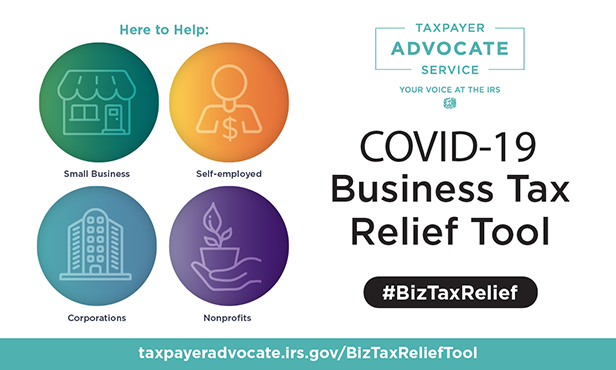Need employment tax relief?
Try our COVID-19 Business Tax Relief Tool now. All you need to do is answer a few questions. It should take less than 5 minutes.

Based on your answers, the tool will:
- Let you know if you may be likely to qualify for any of the available tax relief options.
- Link you to more information that will allow you to understand how to take advantage of those options.
Or you can simply read the information below about the available tax relief options.
Please help businesses affected by the COVID-19 pandemic understand tax relief options to stay in business by sharing this flyer (PDF), the link to this page or the tool’s direct link, via your website, newsletter, email, or social media. Read our TAS Tax Tip: COVID-19 Business Tax Relief Tool for Businesses and Tax-Exempt Entities for more information about this tool, how it works and more.
Employee Retention Credit
The Coronavirus Aid, Relief, and Economic Security Act (CARES Act), enacted on March 27, 2020, is designed to encourage eligible employers to keep employees on their payroll, despite experiencing financial hardship related to the coronavirus pandemic, with an employee retention tax credit (Employee Retention Credit). The refundable credit is 50% of up to $10,000 in wages paid by an eligible employer to employees after March 12, 2020, and before January 1, 2021. For more information, see Employee Retention Credit, Coronavirus Tax Relief for Businesses and Tax-Exempt Entities, Employee Retention Credit FAQs, and Deferral of employment tax deposits and payments through December 31, 2020.
Paid Leave for Workers and Tax Credits for Small- and Mid-Size Businesses
Under the Families First Coronavirus Response Act (FFCRA), businesses can claim two new refundable payroll tax credits. The paid sick leave credit and paid family leave credit are available for eligible employers who pay qualified sick leave wages and/or qualified family leave wages from April 1, 2020, through December 31, 2020, and who have fewer than 500 employees.
Paid sick leave for workers: An employer can allow a full-time employee up to 80 hours of paid sick leave. A part-time employee may be allowed paid sick leave for the number of hours the employee works over a two-week period, if the employee is unable to work or telework because they are:
- Subject to COVID-19 quarantine or isolation order.
- Advised to self-quarantine due to COVID-19.
- Experiencing COVID-19 symptoms and are seeking a medical diagnosis.
- Caring for a person subject quarantine orders related to COVID-19 or has been advised to self-quarantine.
- Caring for a child whose school or place of care is closed or unavailable due to COVID-19.
For an employee who is unable to work because of Coronavirus quarantine or self-quarantine or has Coronavirus symptoms and is seeking a medical diagnosis, an eligible employer may receive a refundable sick leave credit. Employers pay the benefits at 100% of the employee’s regular pay up to $511 per day and $5,110 in total for the care of the employee’s own health.
For the care of an employee’s family members, employers pay benefits at two-thirds of the employee’s regular pay up to $200 per day and $2,000 total.
Paid family leave to care for child: An employer can give up to 10 weeks of paid family leave at two-thirds of an employee’s regular pay for up to $200 per day and $10,000 total if the employee is unable to work or telework because they’re caring for a child whose:
- School or place of care is closed due to COVID-19
- Childcare provider is unavailable due to COVID-19
With two weeks of paid sick leave and 10 weeks of paid family leave combined, an employee could receive up to a total of 12 weeks up to $12,000 of paid leave to care for a child. For more information, see paid leave for employees, New credits fund employers for Coronavirus-related paid leave and Tax Credits for Required Paid Leave FAQs.
Eligible employers are entitled to an additional tax credit determined based on costs to maintain health insurance coverage for the eligible employee during the leave period.
Important note: An employer cannot use the same wages for the Employee Retention Credit and the credits for paid sick and family leave.
How do I receive my credit?
ALERT: Employers will experience a delay in receiving payments associated with Form 7200, Advance Payment of Employer Credits, processed between late-December and mid-January due to standard end-of-year close out. Payment of valid requests during this time will begin to be processed on January 21, 2021.
You can get immediate access to the credits by reducing the employment tax deposits you are otherwise required to make. If your employment tax deposits are not enough to cover the credit, you can request advance payment from the IRS by faxing your completed Form 7200, Advance Payment of Employer Credits Due to COVID-19 to 855-248-0552. Read the instructions carefully and take time when completing this form. IRS has put together a list of common errors to avoid when filing Form 7200. For more information call 833-551-3588.
If you fully reduce your required employment tax deposits otherwise due on wages paid in the same calendar quarter to employees in anticipation of receiving the credits, and you have not paid qualified leave wages in excess of this amount, you should not file Form 7200. If you file Form 7200, you will need to reconcile this advance credit and deposits with the qualified leave wages on Form 941 (or other applicable federal employment tax return such as Form 944 or Form CT-1), and you may have an underpayment of federal employment taxes for the quarter.
Note that a Form 7200 requesting an advance of less than $25 will not be processed. Employers can claim credits of less than $25 on Form 941.
Some Employers Received Notice of Failure to Deposit Penalty after Claiming New Tax Credits
Although the IRS has taken steps to implement rules that prevent the failure to deposit penalty from incurring on employers reducing their deposits in anticipation of claiming the Sick and Family Leave Credits or Employee Retention Credit, some employers may still have inadvertently received notice of the penalty.
No additional actions are needed at this time. The IRS is working to identify these employer accounts and correct them as soon as possible. To avoid receiving a penalty notice in the future, check IRS.gov/form941 for guidance on properly reporting liabilities when reducing deposits.
Delay processing Form 7200
For those experiencing a delay with processing your Form 7200, you will receive one of the following letters from the IRS:
- Letter 6312, if the IRS either rejected Form 7200 or made a change to the requested amount of advance payment due to a computation error. The letter will explain the reason for the rejection or, if the amount is adjusted, the new payment amount will be listed on the letter.
- Letter 6313, if the IRS needs written verification that the address listed on your Form 7200 is the current mailing address for your business. The IRS will not process Form 7200 or change the last known address until the verification is provided.
Repaying excess employment tax credits, when necessary
The IRS recently provided guidance on recapturing excess employment tax credits where any refund of these credits listed above were paid to a taxpayer that exceeds the amount the taxpayer is allowed. This situation is considered an erroneous refund for which the IRS has been authorized to seek repayment. See the temporary regulation and a proposed regulation for how to reconcile advance payments of refundable employment tax credits and recapture the benefit of these credits when necessary.
For more information on the employer credits overall, see Employer Tax Credits and Employer Credit Flow Chart.
Deferral of Certain Employee Social Security Tax Withholding and Payment
The President of the United States issued a Presidential Memorandum directing the Secretary of the Treasury to use his authority pursuant to section 7508A of the Internal Revenue Code to defer the withholding, deposit, and payment of certain payroll tax obligations. As a result, the Department of Treasury and the Internal Revenue Service issued guidance allowing employers to defer withholding and payment of the employee’s portion of the Social Security tax, if the employee’s wages or compensation are below a certain amount. The guidance makes relief available for employers and generally applies to wages or compensation paid starting September 1, 2020, through December 31, 2020.
The employee Social Security tax deferral may apply to payments of taxable wages or compensation to an employee that are less than $4,000 during a bi-weekly pay period, with each pay period considered separately. No deferral is available for any payment to an employee of taxable wages or compensation of $4,000 or above for a bi-weekly pay period.
Payment of Deferred Applicable Taxes
An employer must withhold and pay the total applicable taxes that were deferred under this guidance, ratably from employee wages and compensation paid between January 1, 2021 and April 30, 2021. If not, interest, penalties, and additions to tax will begin to accrue on May 1, 2021, with respect to any unpaid applicable taxes. If necessary, the employer may make arrangements to otherwise collect the total applicable taxes from the employee.
For more information see:
Business Net Operating Losses (NOLs)
For information about business-related Net Operating Losses, see the section above titled Net Operating Losses (NOLs).
More Resources
For more information, see Coronavirus Tax Relief for Businesses and Tax-Exempt Entities on IRS.gov. You can also visit the Department of Labor’s website, Families First Coronavirus Response Act: Questions and Answers.



